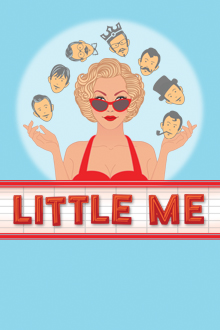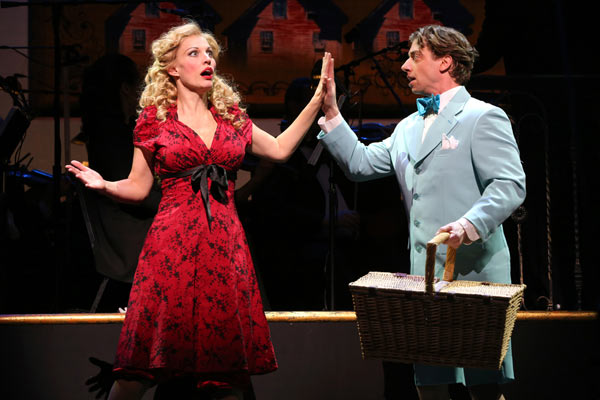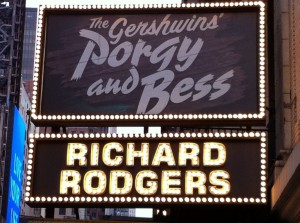That’s Amore!
A review of Encores! concert revival of
THE MOST HAPPY FELLA
At New York City Center – April 6, 2014
by Moshe Bloxenheim, Guest Reviewer
Within the first few minutes of the overture of THE MOST HAPPY FELLA, the strings, horns and cymbals of the overture joined in a musical
exclamation that sent a thrill up my back which pretty much stayed there until the final notes of the evening, when we all began to shuffle out of City Center feeling that we had just witnessed something truly great.
Yet the plot is a simple one, focusing on everyday people; their problems and joys. Mr. Frank Loesser’s book of THE MOST HAPPY FELLA – based on the play THEY KNEW WHAT THEY WANTED by Mr. Sidney Howard – features no villains or changing epochs. Set on and around Tony Espozito’s ranch in Napa Valley, California, THE MOST HAPPY FELLA shows how two ordinary people can pick themselves up from the wreck of their dreams and build something newer and better. Insecure about his age and looks, the Italian-born farmer Tony encloses a picture of his handsome young foreman Joe in a letter to the young lady he has been wooing by mail. When the romantically dubbed Rosabella actually arrives at the farm to meet and marry the farmer she has been writing to for so long, she is tragically disillusioned; not merely learning that her wooer isn’t the handsome young man she had anticipated, but that she also must deal with the crumpled and battered body of the much older Tony who has had a serious accident on his way to pick her up from the train. In shock and yielding to the pleas of the badly injured Tony and his friends, Rosabella marries him. On this tragic wedding night, Rosabella is unable to cope with the total overturn of her expectations and gives herself to the thoughtless but responsive Joe. It is then up to Tony and Rosabella to truly discover each other and try to make some sort of life for themselves. That they triumph so wonderfully and believably in this production is a tribute to both Mr. Loesser and the Encores! company.
If I had to point out the true star of THE MOST HAPPY FELLA it would be Mr. Frank Loesser’s sweeping and amazingly varied score. There are some very beloved standards in this song book; “Standing on the Corner”, “Joey, Joey, Joey” and of course that love song to Urban Texas “Big D.” However, it isn’t just that there are some wonderful tunes. Mr. Loesser’s music and lyrics carry the listener along, unfolding the action and expressing the emotions of the performers. This isn’t drama simply accompanied by song: it is all of one piece. Perhaps that is one reason why there is a tendency to call THE MOST HAPPY FELLA ”operatic.” The developing love of Tony and Rosabella is a simple and beautiful thing to behold, but when they express their joyful desire for one another in the number “My Heart is So Full of You” the show was well and truly stopped by the cries and applause of an audience that was deeply moved.
Excellent music and drama alone was only a part of the sensation that was Encores! THE MOST HAPPY FELLA. The cast sounded great and acted brilliantly. The man of the title, Tony Esposito is a truly good man who wants to achieve something better than he has – marriage, a family, a loving wife. Mr. Shuler Hensley was a very likeable Tony, whom we can easily sympathize with even when he makes the fateful photo switch. Mr. Hesley made it clear that throughout the show that Tony always had that bad deed in the back of his mind and he made us feel for the poor man and root for him as well. Musically, Mr. Hensley acted his songs with intensity rather than trying to be a perfect tenor. Indeed, he was able to use his body mike to great effect, taking moments that might have sounded technically fine in other hands but used a whisper here, an outright shout there or a breaking voice to bring drama and emotion to this rustic farmer. Happily as well, Mr. Hensley’s Tony may not have been the carelessly handsome Joey, but he had a rough-hewn attractiveness too, making Rosabella’s eventual love for Tony on both a physical and emotional level very believable.
Just as convincing was Ms. Laura Benanti’s Rosabella. This character is pretty enough to have men appreciate her, but also smart enough to know that she is one of many attractive waitresses and that she ought to find something better while she has the chance. Ms. Benanti knew how to exhibit both the good humor and fear of a woman who may have seen more of the world than she would have liked to. Rosabella can discover and eventually love the goodness in Tony, and like Tony she is a nice person who makes a mistake that she has to live with. In Ms. Benanti’s characterization, we wanted this heroine to be happy and feel deeply for her when things go wrong. Rosabella was already touching in her songs like “Somebody Somewhere” but once she meets Tony, Ms. Benanti musically met Mr. Hensley on equal terms of emotional power and dramatic skill.
I overheard someone describe Mr. Cheyenne Jackson’s Joey as “detached,” but is that a bad thing for this drifting foreman? Handsome and sounding better than ever, Mr. Jackson showed someone who wants to keep to himself free of any complications. When Joey feels that he is developing roots he pulls up and moves on. Mr. Jackson clearly understood that somebody like that would avoid emotional investment in the people around him. He was at his most emotionally open when he wistfully sang about leaving in the memorable “Joey, Joey Joey.”
Another isolated soul is Tony’s spinster sister Marie. Marie has long been Tony’s caregiver and support. She does not want to be hateful but she does not want her brother and Rosabella to be husband and wife either. So Ms. Jessica Molaskey had a difficult task as Marie: how could she show a woman who wants to break up our hero and heroine without making her an out and out villainess? Ms. Molaskey presented a very frightened woman who fears a future she cannot imagine. Even with her verbal digs at Tony and her concern over Rosabella we could feel sympathy with Marie who is seeing the life she worked so hard at getting changed beyond recognition. Indeed, Ms. Molaskey’s Marie made me wish that we might have seen more of her feelings and interactions. As it was, this Marie clearly had a story and a life outside of the play we were watching.
Only one person seemed to actually dislike Marie and in the number “I Don’t like This Dame” Ms.Heidi Blickenstaff’s Cleo brought the house down with her feelings, all the while politely acknowledging Marie’s doubts about Tony and Rosabella. Of course, Ms. Blickenstaff brought down the house with happy frequency. Cleo is the classic “second lead,” the one that the hero and heroine rely on to let them express thoughts that would otherwise be monologues and who points out destinies that might not be so easily seen. In life this is usually called “a best friend” and Ms. Blickenstaff made Cleo a supremely marvelous and credible pal to Rosabella… and who doesn’t love a buddy who pulls out a belly laugh with the same facility as she can generate cheers?
A perfect match for Cleo was Herman, the young ranch hand who “…likes ev’rybody.” Mr. Jay Armstrong Johnson played Herman as a truly sweet and amusing man who can never imagine the worst about anyone: If someone plays a trick on Herman, well; it makes them happy and hurt him none. Mr. Johnson carried this off with a real innocence so that even though Herman may be laid back and naïve, he was never an imbecile. Together with Messrs. Ryan Bauer-Walsh, Ward Billeisen and Arlo Hill, Mr. Johnson performed the wistful “Standing on the Corner” creating one of the most delightfully memorable moments of the show.
Mr. Kevin Vortmann was highly praiseworthy as the Doctor – a sincere medical man with a surprisingly fine sense of humanity as we discover in the superb “Love and Kindness” and the warming “Song of a Summer Night.”
It would be wrong not to mention other brief but vital contributions to THE MOST HAPPY FELLA: Mr. Wayne Prentlow as the Postman and Messrs. Zachary James, Bradley Dean and Brian Cali as Giuseppe, Pasquale and Ciccio who truly gloried in “Abbondanza” and kept right on going.
The rest of the cast was just plain delightful whether singing and dancing up a storm or lulling us along with a quiet ensemble piece.
If the company and material did a lot for the success of THE MOST HAPPY FELLA then Director and Choreographer Casey Nicholaw’s efforts were just as significant. Using the respectful concert adaptation by Mr. Bill Rosenfeld, Mr. Nicholaw made a rather lengthy show feel as if it ended all too soon. It is a tribute to him that the combined second and third acts of the show moved along as effectively and smartly as the first. Not only was the pacing well done, but even the smaller roles seemed to fill out and add to the vitality onstage. His staging of the dances was just as commendable, creating a “Big D” number that really packed a punch . Yet Mr. Nicholaw excelled at the smaller intimate moments too – from the already mentioned “My Heart is So Full of You” showstopper to heartbreaking moments between Rosabella and Tony that generated audible sobs from the audience.
Alas, not all the directorial decisions were perfect. While I actually liked the idea of Marie’s reconciling with the fact of Tony’s and Rosabella’s being together in the final scene of the show, I thought Mr. Nicholaw’s staging messed up the relationships between Tony, Marie and Rosabella and removed the purpose of Cleo and Herman’s number “I Made A Fist”:
· If Tony was not shown as lame anymore, why did Marie’s keeping hold of his cane (which he hates using) prevent him from going after Rosabella and triggering the final outburst?
· Once Marie and Tony resolved their issue, he never went offstage to get Rosabella as a man determined to keep his wife ought to. So what was all the fuss with that cane in the first place?
· Tony and Marie remaining onstage distracted from Cleo and Herman celebrating Herman’s willingness to fight for Cleo (a moment clearly intended to let Tony go offstage to get Rosabella back as well as ease the overall tension before Tony and Rosbella have their final quiet moment). So Cleo and Herman now just seem to be in the way and their number looks badly placed.
· After all this, Rosabella walked back onstage as if she was wondering where everyone was and Tony did not have the physical chance to show how he was going to go and bring her back.
With everything else so wonderful, this was just too bad and too late in the performance to be ignored; on the other hand there is nothing I could say to criticize the glorious sound of the augmented (38 pieces!) Encores! Orchestra under the musical direction of Mr. Rob Berman and using Mr. Don Walker’s original orchestrations. The only disappointment I’d have there would be if the company did not get back together to at least record this extraordinary music.
Like all of Encores! Musicals in Concert, there may be a full – in this case fuller – orchestra onstage, but Mr. John Lee Beatty cleverly set the remaining part of the stage with enough suggestions of place to keep anyone from ever missing full scenery. He was helped in this by Mr. Ken Billington’s very evocative lighting.
Naturally the cast’s clothing also set the location and Costume Designer Gregg Barnes went to town on the farm, defining the actors most convincingly and attractively.
Sound Designer Scott Lehrer clearly knew how to keep everyone sounding their best, but it was when Mr. Shuler Hensley made the best use of the amplification to add impact to his songs that I began to really appreciate what miking can do in a theater.
What with the narrow stage and all the sets, props and people, I can only express admiration at how Production Stage Manager Ms. Karen Moore and her crew always keep things running so smoothly and so well.
I am just sorry that the run of THE MOST HAPPY FELLA is over now. Would I see it again?
Happily, and repeatedly.
Still, there is something about these limited runs that make them very special: I feel mighty grateful when Encores! gives some of the lesser works a well-deserved chance to shine, but even more so when FRANK LOESSER works are shown.
About the reviewer:
 I am a computer programmer, wannabe writer who loves theater and just got into the habit of inflicting my theatrical opinions.
I am a computer programmer, wannabe writer who loves theater and just got into the habit of inflicting my theatrical opinions.
I live in New York.
Moshe can be reached at MB1224@aol.com




 There is a scene in the first act of “Soul Doctor,” one that features the characters of Nina Simone and Rabbi Shlomo, a piano, a chair, and a tip jar. She smokes and plays, he sits and frets, and through the scene they invariably sew their souls together in conversations of race, heartache and loss, and the healing and spiritual power of music. The scene, lovingly performed by Eric Anderson as Rabbi Shlomo Carlebach and Amber Iman as Nina Simone, is at the heart of “Soul Doctor,” which opens on Broadway tonight at the Circle in the Square Theater. As wonderful as this scene is, unfortunately the soul of this musical has been buried in Rabbi Shlomo’s storied rise to Jewish music stardom; the show suffers, as with many biographical plays, the need to incorporate one person’s timeline in flashbacks, a series of “highlight reel” scenes, and offers many unanswered questions while never taking the time to explore all the varied themes it introduces.
There is a scene in the first act of “Soul Doctor,” one that features the characters of Nina Simone and Rabbi Shlomo, a piano, a chair, and a tip jar. She smokes and plays, he sits and frets, and through the scene they invariably sew their souls together in conversations of race, heartache and loss, and the healing and spiritual power of music. The scene, lovingly performed by Eric Anderson as Rabbi Shlomo Carlebach and Amber Iman as Nina Simone, is at the heart of “Soul Doctor,” which opens on Broadway tonight at the Circle in the Square Theater. As wonderful as this scene is, unfortunately the soul of this musical has been buried in Rabbi Shlomo’s storied rise to Jewish music stardom; the show suffers, as with many biographical plays, the need to incorporate one person’s timeline in flashbacks, a series of “highlight reel” scenes, and offers many unanswered questions while never taking the time to explore all the varied themes it introduces. dable love.
dable love.
 (646) 961-3942
(646) 961-3942
